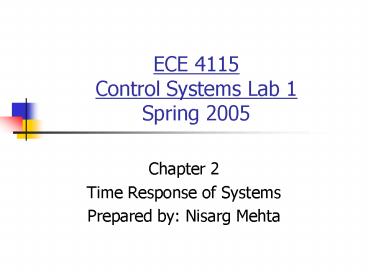ECE 4115 Control Systems Lab 1 Spring 2005 - PowerPoint PPT Presentation
1 / 36
Title:
ECE 4115 Control Systems Lab 1 Spring 2005
Description:
ECE 4115. Control Systems Lab 1. Spring 2005. Chapter 2. Time Response of Systems ... When invoked with left-hand arguments, [y,t]=impulse(sys) returns the output ... – PowerPoint PPT presentation
Number of Views:52
Avg rating:3.0/5.0
Title: ECE 4115 Control Systems Lab 1 Spring 2005
1
ECE 4115Control Systems Lab 1Spring 2005
- Chapter 2
- Time Response of Systems
- Prepared by Nisarg Mehta
2
Matlab
- Start ? Run ? \\laser\apps
- Open MatlabR14 and double click on MATLAB 7.0.1
3
Previous Class
- 4 basic types of LTI models
- Transfer Function tf, tfdata
- Zero-pole-gain model zpk, zpkdata
- State-Space models ss, ssdata
- Frequency response data frd
- Conversion between models
- Model dynamics pzmap, pole, eig, zero, dcgain
4
TIME RESPONSE OF SYSTEMS
- Once a model of a system has been defined, we
might be interested in knowing the time response
of such system to a certain input. - The Control Systems Toolbox of MATLAB provides
several commands to perform this task.
5
Objectives
- Impulse Response (impulse)
- Step Response (step)
- General Time Response (lsim)
- Polynomial multiplication (conv)
- Polynomial division (deconv)
- Partial Fraction Expansion (residue)
6
Impulse Response
- The impulse response of a system is its output
when the input is a unit impulse.
7
Impulse Response
8
Impulse Response
9
Step Response
- The step response of a system is its output when
the input is a unit step.
10
Step Response
11
Step Response
12
Problem 1
- Problem 1 Given the LTI system
- Plot the following responses for
- a) The impulse response using the impulse
command. - b) The step response using the step command.
- c) The response to the input
calculated using both the lsim and the residue
commands
13
H\ECE4115\Chp2\Chp2_1.m
- clear all
- close all
- clc
- A3 2
- B2 4 5 1
- systf(A,B)
- t00.0110
- impulse(sys,t) Impulse Response
- figure
- Step(sys,t) Step Response
14
Response to a general input
- The general response of a system to any input can
be computed using the lsim command.
15
Response to a general input
16
Response to a general input
17
Problem 1
- Problem 1 Given the LTI system
- Plot the following responses for
- a) The impulse response using the impulse
command. - b) The step response using the step command.
- c) The response to the input
calculated using both the lsim and the residue
commands
18
H\ECE4115\Chp2\Chp2_1.m
- clear all
- close all
- clc
- A3 2
- B2 4 5 1
- systf(A,B)
- t00.0110
- Impulse response
- impulse(sys,t)
19
H\ECE4115\Chp2\Chp2_1.m
- Step response
- figure
- step(sys,t)
- Response to a sinusoidal input
- usin(0.5t)
- figure
- lsim(sys,u,t)
20
Commands conv and deconv
21
Polynomial Multiplication
The polynomial product can be solved in
MATLAB by typing Cconv(1 3 -1,2 -4 3) and
the following output will be obtained C 2
2 -11 13 -3
22
Polynomial Division
- The polynomial division
- can be computed in MATLAB by entering
Q,Rdeconv(1 6 11 6,1 2) and the output is - Q
- 1 4 3
- R
- 0 0 0 0
23
Command Residue
24
Command Residue
25
Command Residue
26
Problem 2
- Problem 2 Given the LTI system
- Find the step response using the residue
command. Plot such response for
27
Problem 2 Solution
Recall that To determine the Inverse
Laplace Transform of a rational function, a
partial fraction expansion is performed first,
then each fraction is inverted and the individual
inverse transforms are added up.
28
H\ECE4115\Chp2\Chp2_2.m
clear all close all clc A3 2 B1 5 8
4 Buconv(B,1 0) r,p,kresidue(A,Bu)
29
Chp2_2.m Solution
r -1.50000000000000 -2.00000000000000
1.00000000000000 0.50000000000000 p
-2.00000000000000 -2.00000000000000
-1.00000000000000 0 k
30
Problem 3
- After the partial fraction expansion has been
determined, it can be seen that - Y(s) has four poles, stored in vector p.
- One of them is a repeated pole
- Then, y(t) is given by
31
H\ECE4115\Chp2\Chp2_3.m
- clear all
- close all
- clc
- A3 2
- B1 5 8 4
- systf(A,B)
- t00.0110
- Step response
- ystep,tstep(sys,t)
32
H\ECE4115\Chp2\Chp2_3.m
- Step response via the Inverse Laplace Transform
- Bu conv(B,1,0)
- r,p residue(A,Bu)
- ystep_resr(1)exp(p(1)t)r(2)t.exp(p(2)t)
- r(3)exp(p(3)t)r(4)exp(p(4)t)
- Figures
- subplot(2,1,1),plot(t,ystep_res,'k')
- xlabel('t')
- ylabel('y')
- subplot(2,1,2),plot(t,ystep,'k')
- xlabel('t')
- ylabel('y')
33
Figures
- The following Figure shows the step response
using the Inverse Laplace Transform (a) and the
step command (b)
34
Summary
- Impulse response Impulse
- Step response Step
- General time response lsim
- Polynomial multiplication conv
- Polynomial division deconv
- Partial fraction expansion residue
35
Homework 2
- H\ECE4115\Chp2\HW2_1.m
- H\ECE4115\Chp2\HW2_2.m
- H\ECE4115\Chp2\HW2_3.m
36
Questions???
- Next Class March 25th,2005

